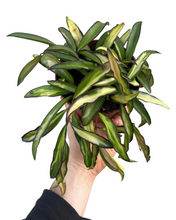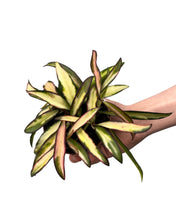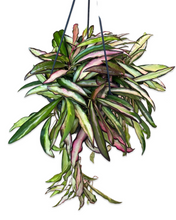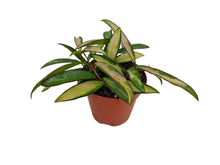Hoya wayetii is part of the Apocynaceae family and is native to the Philippines. The leaves are narrow and thick with dark leaf margins. Variegation is splashes of pink and creamy yellow. Umbels contain between 15 & 25 flowers, these are recurved in shape with a pink corona and yellow and dark red corolla. Blooms are said to have a scent of honey.
It was Maximo Wayet (former gardener for Professor Juan Pancho of University of the Philippines Los Banos) who collected the type material for this species (Hoya wayetii) in 1989 on the way to his wife's village North of Baguio in Quirino Province. (The World of Hoyas, Dale Kloppenburg, 1999)
Genus name is new Latin, named after Thomas Hoy ( c. 1750– c. 1821), English gardener. Specific epithet honors Maximo Wayet.
Light: Bright indirect light, meaning the plant sees the sun for 0-4 hours per day - this could be through trees or a translucent curtain, it’s important for the plant to see the sky in order to thrive. More hours of light are thought to encourage flowering.
Water: Given adequate light, allow the mix to dry out a little. If your Hoya is potted in a chunky, fast draining mix, you may need to water more frequently.
Potting mix: A chunky well-draining mix composed of coco coir, perlite or vermiculite, orchid bark, worm castings and some horticultural charcoal. I also recommend potting Hoya in coco chips.
Fertilising: Feed your plant every few waterings during the growing season or when you observe active growth. You can dilute fertiliser to half the recommended amount but never add more.
Temperature: 15-35˚C.
Humidity: Hoya would prefer higher humidity, between 60-80% but do well to adapt to average home humidity. You can increase humidity by placing the plant on a watered pebble tray or using a humidifier.
Hoya aren’t considered toxic, however, they may make your pet or child vomit if ingested, keep out of reach just to be safe.







